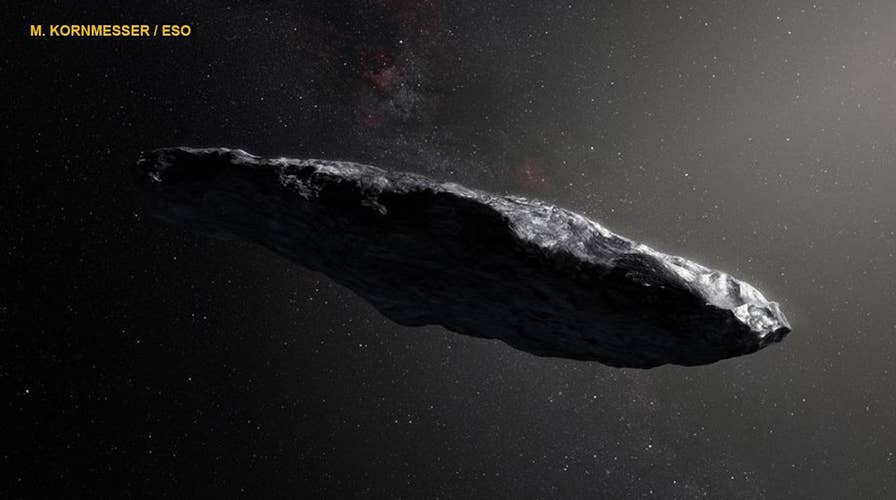Mysterious interstellar object could be alien 'lightsail'
A new study from the Harvard Smithsonian Center for Astrophysics says Oumuamua, the first interstellar object ever spotted in our solar system, could be 'a lightsail of artificial origin' sent from another civilization.
The mystery of Oumuamua, the first interstellar object ever spotted in our solar system, has taken a new, unexpected twist and it's from someone you might not expect – NASA.
In a new study published in the Astronomical Journal, the government space agency reveals that when it was looking at the interstellar object in November with its Spitzer Space Telescope, it came up with — nothing.
"'Oumuamua was too faint for Spitzer to detect when it looked more than two months after the object's closest aproach [sic] to Earth in early September," NASA said in a release accompanying the study. "However, the 'non-detection' puts a new limit on how large the strange object can be."
MYSTERIOUS INTERSTELLAR OBJECT COULD BE 'LIGHTSAIL' FROM ANOTHER CIVILIZATION
NASA also noted that Oumuamua, the Hawaiian name for "pathfinder" or "scout," was exceptionally bright, perhaps up to 10 times more reflective than comets that are usually found in our solar system.
"'Oumuamua had been traveling through interstellar space for millions of years, far from any star that could refresh its surface," NASA added in the statement. "But it may have had its surface refreshed through such 'outgassing' when it made an extremely close approach to our Sun, a little more than five weeks before it was discovered. In addition to sweeping away dust and dirt, some of the released gas may have covered the surface of 'Oumuamua with a reflective coat of ice and snow - a phenomenon that's also been observed in comets in our solar system."
The study's abstract only adds further intrigue as to why NASA never saw it when it pointed its telescope at the object in November.
"Both our size and outgassing limits are important because 'Oumuamua's trajectory shows non-gravitational accelerations that are sensitive to size and mass and presumably caused by gas emission," the study's abstract reads. "We suggest that 'Oumuamua may have experienced low-level post-perihelion volatile emission that produced a fresh, bright, icy mantle."
NASA added that it placed limits on how much carbon monoxide and carbon dioxide were expected to come from the object, but added that another gas species — "probably H2O" — caused the "observed non-gravitational acceleration."
Oumuamua was discovered in October 2017 by Canadian physicist and astronomer Robert Weryk.
MYSTERIOUS INTERSTELLAR OBJECT IS NOT AN ALIEN PROBE, SAYS ASTRONOMER WHO DISCOVERED IT
Because of the varying degrees of brightness emanating from Oumuamua's surface, NASA suggests it is "highly elongated and probably less than half a mile (2,600 feet, or 800 meters) in its longest dimension."
The intrigue of what Oumuamua is or isn't has picked up a considerably over the past few weeks, especially as some researchers have theorized that it could be an object from an extraterrestrial civilization.
A study from the Harvard Smithsonian Center for Astrophysics says the object could be "a lightsail of artificial origin" sent from another civilization. "Considering an artificial origin, one possibility is that ‘Oumuamua is a lightsail, floating in interstellar space as a debris from an advanced technological equipment," researchers Shmuel Bialy and Abraham Loeb wrote in a paper.
Weryk called that idea preposterous and just "wild speculation," though he did note that the speed of the object was unusual.
"There's a maximum speed that you can be traveling to be bound gravitationally by the sun," Weryk told Canadian outlet CBC in an interview. "When we first saw this object, it was traveling faster than that, so we know for a fact that it's from outside our solar system. We decided that it was a comet that had a bit of outgassing that wasn't visible from the ground, which is why it didn't appear to be a comet."
He continued: "(The Harvard researchers) decided to focus on another aspect of that, that it's an alien spacecraft and that it has a solar sail type material that's causing the non-gravitational trajectory. But we actually believe that's not true based on the data we obtained."
In an email to Fox News, Loeb said his and Bialy's paper "attempts to explain the excess force" that acted on Oumuamua when observed and Weryk's reaction "shows prejudice."
COMETS AND ASTEROIDS COULD BE FLINGING LIFE ALL OVER THE GALAXY, STUDY FINDS
"Our paper follows the standard scientific methodology: an anomaly is observed in data, the standard explanation fails to explain it and so an alternative interpretation is proposed," Loeb wrote in the email. "I encourage anyone with a better explanation to write a paper about it and publish it. Any wrong interpretation can be ruled out when more data will be released on `Oumuamua or other members of its population in the future. A reaction of the type you quoted shows prejudice."
NASA has been steadfast that it is a "metallic or rocky object" and is likely a comet.
So will we ever learn more about why it was so bright or why it has unusual acceleration?
INTERSTELLAR VISITOR 'OUMUAMUA' NEVER SHOULD HAVE LEFT HOME, THEORIES SAY
“Usually, if we get a measurement from a comet that’s kind of weird, we go back and measure it again until we understand what we’re seeing,” said NASA’s Davide Farnocchia, one of the study's co-authors. “But this one is gone forever; we probably know as much about it as we’re ever going to know.”
Follow Chris Ciaccia on Twitter @Chris_Ciaccia




















